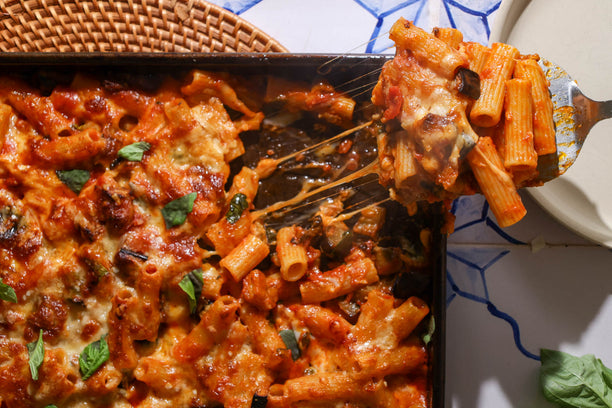Tracing the Italian roots of some of the most beloved American dishes.
Speak about a beloved Italian American dish like fettuccine alfredo and you’re guaranteed to hear a chorus of “But it’s not really Italian!” And while it’s absolutely true that many of the foods that Americans call “Italian” won’t be found in Italy, that doesn’t mean they’re not perfectly valid (and perfectly delicious!). In fact, many of those classic Italian American dishes really do have their roots in Italy, if you just know where to look.
Between 1890 and 1920, millions of young Italians from Campania, Calabria, and Sicily emigrated to the United States. Known as the Great Arrival, this wave of immigration from Southern Italy was sparked by extreme poverty, a string of natural disasters in the region, and the rise of transatlantic steamship travel, which gave people a direct route to New York’s Ellis Island for the first time.
When they landed in the U.S., these immigrants from Southern Italy went to work making the dishes they knew using the foods that were available to them. Giada has shared how when her family moved from Rome to California in the 1970s, her mother struggled to find the ingredients to make her favorite recipes. Looking back another half-century or more, it’s a wonder that this first wave of ingenious Italian immigrants were able to make anything that resembled the foods of their homeland!
The results of their creativity are what we know today as classic Italian American cuisine. Each dish is rooted in Italian tradition, evolved by necessity and the passing of time into something new. Here, we’ve traced the Italian roots of some of our favorite Italian American dishes. The next time someone tells you they aren’t really Italian, tell them you know the full story!

Chicken Parmesan
In 19th-century Italy, meat of all kinds was a rare delicacy for most Southern Italians, especially chicken. Chickens were only eaten once they’d become too old to lay eggs – at which point their meat was so tough it had to be braised or made into soup. When they arrived in the U.S., Italian immigrants were astounded at the availability and affordability of beef and chicken and looked for ways to add these luxuries into their meals. Sicilians took their melanzane alla parmigiana, a classic method for turning eggplant into a hearty meal by breading and frying it, then cooking in tomato sauce and topping with fresh mozzarella, and made it an American classic by using thin chicken cutlets instead.

Cioppino
All along the Italian coast, seafood is a staple. For millennia, working people have depended on the abundant protein that thrives in the Mediterranean. A zuppa di pesce (called ciuppin in Genoa) is one of the best ways to use the small bits and pieces from the day’s catch, combined into a savory soup with lots of delicious variety. In San Francisco in the late 1800s, Italian immigrants took to fishing off of Meiggs Wharf just as they had done back home, using the Pacific Ocean’s bounty of prawns, clams, and fish like halibut to make their own soup, which became known as cioppino.

Spaghetti and Meatballs
In most parts of Italy, you’ll never find polpette (meatballs) served with pasta. Cooked in tomato sauce, you’ll see meatballs served alone, enjoyed with some bread to soak up the sauce. But in the eastern region of Abruzzo, there is a classic dish called spaghetti con le pallotine, using the local favorite spaghetti chitarra and teeny tiny meatballs. In coming to the U.S., this dish just got bigger, taking advantage of that abundant American beef and pork to supersize the meatballs until they got big enough to tower over the plate. The result? A childhood favorite for countless Italian Americans.

Fettuccine Alfredo
Though you might assume this creamy pasta is another ingenious immigrant invention, this is the one dish on our list with a more glamorous origin story. It was born in Rome as fettuccine al burro, a simple sauce of parmigiano reggiano and lots of butter created by chef Alfredo Di Lelio to please his pregnant wife and a staple on the menu at his Ristorante Alfredo. In the 1920s, Hollywood’s first power couple, Douglas Fairbanks and Mary Pickford, were so taken by Alfredo’s fettuccine that they tried to copy it for their own dinner parties back home. When they couldn't master the emulsification of cheese and butter into a sauce, they added heavy cream to the mix, and the American fettuccine alfredo was born.

















0 comments